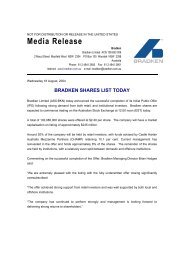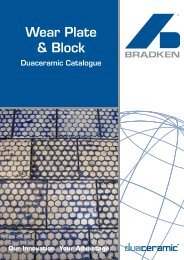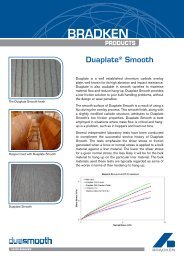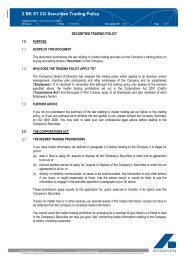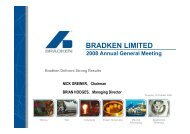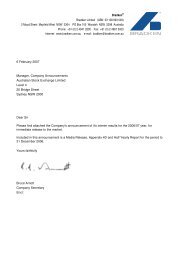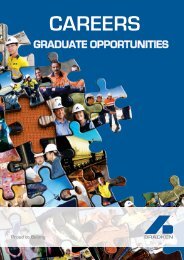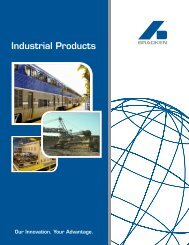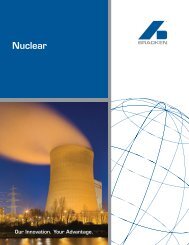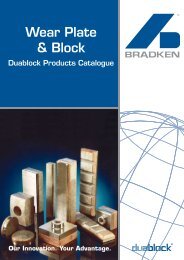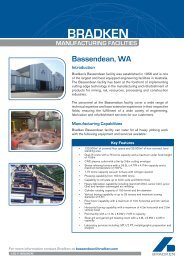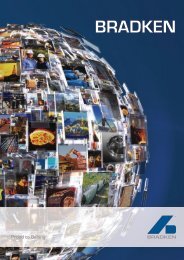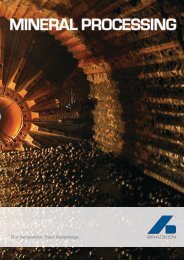Company History - Bradken
Company History - Bradken
Company History - Bradken
Create successful ePaper yourself
Turn your PDF publications into a flip-book with our unique Google optimized e-Paper software.
<strong>Bradken</strong><br />
<strong>Company</strong> <strong>History</strong><br />
As the leading global supplier of differentiated consumable and capital products, <strong>Bradken</strong> sales<br />
offices and manufacturing facilities are strategically located to service the global resources, energy<br />
and freight rail industries.<br />
<strong>Bradken</strong>’s five market focused divisions<br />
• Mining Products<br />
• Rail<br />
• Engineered Products<br />
• Industrial<br />
• Power & Cement<br />
provide quality products and services, drawing on its years of experience, from modest beginnings<br />
as a steel foundry in the 1920's. Today, <strong>Bradken</strong>’s product range includes innovative and<br />
differentiated consumable and capital products for the mining, power generation, rail, steel making,<br />
smelting, transport, sugar and cement industries.<br />
It's a far cry from its humble beginnings, which were<br />
grounded in a lot of luck, some true entrepreneurial<br />
spirit and a dedicated commitment by its founders.<br />
Bradford Kendall Ltd was incorporated on 20th<br />
March 1922 after two BHP steelworks employees -<br />
Leslie Bradford (General Manager) and Jim Kendall<br />
(Chief Mechanical Engineer), got lucky at the races<br />
one day in 1920 and pledged the £15,000 winnings<br />
to start the steel foundry business. The horse they<br />
backed, ‘Jack Findlay' completed a remarkable<br />
sequence of five wins during 1919 and 1920.<br />
Each time Leslie Bradford and Jim Kendall, and a group of friends, rolled-over their bets, and by the<br />
24 January 1920 they had won a small fortune. On the 28 April 1920, Bradford and Kendall used<br />
their winnings to establish the Alloy Steel Syndicate to build a steel foundry in Alexandria, Sydney<br />
to take advantage of what they saw as an untapped potential for industrial growth. While there were<br />
a number of larger foundries specialising in engine castings and other industrial products, the<br />
foundry industry was limited, consisting primarily of small regional foundries producing largely iron<br />
and brass, and focused on providing products to restricted markets.<br />
From the beginning the family-orientated company took a customer-focused approach to business<br />
and developed a commitment to research and development.
It used well-qualified and experienced technical specialists, ensuring its product developments met<br />
customer needs and expectations in terms of safety, performance and cost-effectiveness.<br />
Originally <strong>Bradken</strong> made contract castings for industry in general before moving into manufacture of<br />
licensed products in the form of railway couplers and undercarriages in 1926. This development led<br />
<strong>Bradken</strong> into the first of many strategic business relationships, forming, for example, a close<br />
affiliation with American Steel Foundries (ASF) which still exists today.<br />
Established in the boom years of the 1920s, the company quickly had to adjust to the bad years of<br />
the Great Depression. This was the first real test of the company's character, and it proved<br />
extremely good at adapting to change. During these years it not only survived, but excelled,<br />
supplying manganese steel products to the mining industry and eventually manufacturing dredge<br />
buckets for the Malayan tin mining industry - the first step in developing the company's export<br />
business.<br />
Following the Great Depression, it faced the prospect of slowing demand for its main business of<br />
supplying railway requirements. As World War II began to take hold, Bradford Kendall recognised<br />
Australia's changing needs and switched foundry production to armament castings - a move that<br />
proved very lucrative.<br />
The company was engaged by the Commonwealth Government to build a foundry for making cast<br />
armour for the Australian built tank program. While it began by producing aerial bombs, naval gun<br />
parts and tank hulls, its biggest contribution to the war effort was the development, in 1940, of the<br />
world's first one-piece cast tank hull, which was created through the company's own initiative and<br />
expense. The Ministry of Munitions accepted the Cruiser tank design and <strong>Bradken</strong> was<br />
commissioned to make the tanks as part of the war effort.<br />
After the war, Bradford Kendall Ltd<br />
experienced a great surge of growth<br />
boosted by Australia's need to<br />
rehabilitate its neglected railway<br />
systems. The introduction of diesel<br />
electric locomotives, and the demand<br />
for higher speed and larger capacity<br />
freight trains, were also key forces<br />
behind the company's growth.<br />
In 1948, it took advantage of this boom and listed on the Sydney Stock Exchange. This growth<br />
surged on into the 1950s when a number of Bradford Kendall foundries were built in South<br />
Australia, Western Australia, Victoria and Queensland. The company carried out all the design,<br />
engineering and construction of its plants, adopting the latest international concepts. In 1954 it<br />
acquired the ESCO licenses (a leading edge foundry technology company specialising in cast<br />
products) and since then <strong>Bradken</strong> has successfully made an extensive range of ESCO ground<br />
engaging tool castings.<br />
During the 1960s and 70s the company continued to expand its local perations, as well as build on<br />
its early export success. In December 1974 the company officially changed its name to <strong>Bradken</strong><br />
Consolidated Limited, following the formation of a new subsidiary, Bradford Kendall Foundries Pty<br />
Limited in 1973. But in the early 1980s the company fell on hard- times and in 1982 was purchased<br />
by Australian National Industries (ANI), which had built up its stake in the company since the late<br />
1970s. <strong>Bradken</strong> effectively became a division of ANI. At this time, ANI also comprised a number of<br />
specialised engineering divisions including ANI Ruwolt, ANI Arnall, ANI Hoskins and the<br />
Engineering Services group which itself consisted of five autonomous engineering entities. It was<br />
during this period that <strong>Bradken</strong>'s fabrication division, on the back of the manufacturing and servicing<br />
of a range of draglines for the mining industry, embarked on a phase of unprecedented growth.
During the 1980s and early 90s, <strong>Bradken</strong>'s<br />
engineering division came to the fore. It completed<br />
the fabrication, construction and supply of a broad<br />
range projects from cranes and storage units to<br />
numerous draglines, including a Marion 8750<br />
Dragline for Curragh Queensland Mines - one of<br />
the largest modern draglines in Australia, with an<br />
operating weight of 6,600 tonnes.<br />
In October 1990 ANI moved its head office, from<br />
its original location at Alexandria, back to where its<br />
founders had first worked together, Newcastle. At<br />
this time, ANI changed its organisational structure<br />
to incorporate its diverse facilities into strategic<br />
manufacturing and distribution groups by creating<br />
ANI Manufacturing and ANI Product Group.<br />
<strong>Bradken</strong>, Comsteel and ANI Ruwolt amalgamated<br />
to form ANI Manufacturing, with a focus on engineering and manufacturing development. ANI<br />
Product Group was formed through the amalgamation of ANI Arnall, ESCO Products and ANI<br />
Hoskins, and was to focus on the mining, mineral processing and wear parts markets.<br />
In 1994, as part of a management restructure undertaken by ANI, the ANI Engineering division was<br />
created. The division comprised ANI Ruwolt, ANI Hoskins, ANI's grinding mills business, the<br />
crusher spare parts and service business and ANI's Australian Environmental Engineering<br />
business. This restructure was designed to ensure that all facets of engineering activities covered<br />
by ANI were incorporated into one centralised business.<br />
The late 1990s saw the company undergo some of the biggest changes in its history. In October<br />
1997 <strong>Bradken</strong> went through a major restructure, regionalizing its sales force and rationalising its<br />
foundries. Then in January 1999, ANI was taken over by Smorgon Steel Group. Since that time,<br />
<strong>Bradken</strong> has divested its offshore businesses while folding in the ANI Businesses of ANI Wear<br />
Resistant Products, ANI Mineral Processing and ANI Engineering to form the company that exists<br />
today.<br />
Throughout this period of restructuring, <strong>Bradken</strong>'s fabrication and heavy engineering remained a<br />
major source of the company's growth. It continues to fulfill major projects throughout Australia, with<br />
recent projects including a deal to construct over 700 coal wagons for Queensland Rail and another<br />
contract to supply nearly 650 iron ore wagons for Hamersley in WA - using BHP plate steel to fulfill<br />
the demand.<br />
In 2001, <strong>Bradken</strong> changed hands again, with Smorgon Steel Group announcing the sale of the<br />
company to CHAMP (Castle Harlan Australian Mezzanine Partners Pty Ltd), United States-based<br />
ESCO Corporation and <strong>Bradken</strong> Management.<br />
The business underwent considerable restructuring, with significant capital injection by the owners<br />
to improve the operational efficiency of the business and become globally competitive in the major<br />
resource and rail markets. In August 2004, <strong>Bradken</strong> Limited listed on the Australian Stock<br />
Exchange and reached sales of $400 million with 2,000 employees. The same year, ESCO<br />
Corporation and <strong>Bradken</strong> celebrated a 50 year prosperous relationship.<br />
Prior to these ownership changes, <strong>Bradken</strong> had remained a very tight-knit family affair. While Leslie<br />
Bradford (Director) and Jim Kendall (Chairman and Managing Director) were the founders, they<br />
were both committed to keeping the business in family hands. This commitment saw Mr Bradford's<br />
son, George Bradford, serve as a director at <strong>Bradken</strong> for 35 years, 28 as a chairman, and Mr<br />
Kendall's son succeed his father as Managing Director, a position he held for 36 years. Both sons<br />
retired in the late 1970s when it came under the control of ANI and Comeng Holdings.<br />
In the following years, <strong>Bradken</strong> acquired the Roche Castings Henderson foundry, Geoff Brown &<br />
<strong>Company</strong> specialty scrap steel merchants, Wundowie foundry, Firth Rixson Castings and<br />
AmeriCast, Inc.
<strong>Bradken</strong> believes this restructuring process, change of ownership and significant acquisitions place<br />
it in a unique position to face any upcoming challenges and to pursue its growth strategies<br />
aggressively.<br />
Throughout the years, <strong>Bradken</strong> has retained a close relationship with BHP. This is nowhere more<br />
evident than when looking at the management of <strong>Bradken</strong>. Before he and Jim Kendall pooled their<br />
race winnings to create <strong>Bradken</strong> all those years ago, Leslie Bradford had worked for BHP. He<br />
remained with BHP after <strong>Bradken</strong>'s creation and during his 45 year career at BHP worked his way<br />
up to General Manager and then Chief Executive Officer. Similarly Jim Kendall worked at BHP as a<br />
Chief Engineer.<br />
This relationship was reinforced when ANI moved the <strong>Bradken</strong> Head Office to Newcastle in 1990,<br />
creating many opportunities for local employees especially ex- BHP employees. This relationship<br />
continues today, with <strong>Bradken</strong>'s current Managing Director, Brian Hodges, a former chemical<br />
engineering trainee with BHP Newcastle, having worked for BHP for over 20 years.<br />
More than luck was needed to stay in business through the great depression, World War II and to<br />
survive the early 80s and subsequent takeovers.<br />
<strong>Bradken</strong>'s story - and a remarkable one at that - is of a customer-friendly company, committed to<br />
providing innovative products. Built on luck, mateship and strong family ties, its success has come<br />
from its ability to adapt and change direction to suit market demand. Its focus on customers and its<br />
willingness to research and develop new, innovative products ensure it remains at the forefront of<br />
its business.




